Propagating lavender isn’t difficult, and it’s a fun way to get more plants for your garden. Plus you can share them with your friends and family.
In this post, I’ll show you everything you need to know, including the different methods you could use, when is the best time to do it, and how to take and prepare your cuttings.
Then I’ll give you the detailed step by step instructions for exactly how to propagate lavender in either soil or water, with care and transplanting tips too.
Lavender Propagation Methods
There are two different ways you could propagate your lavender plants: by rooting cuttings, or from seed.
- Rooting cuttings – This is the most popular and fastest method, and the one I will focus on in this guide.
- From seed – You could also try growing your lavender from seeds, though it is a bit more difficult and it will take longer to get sizable plants.
When To Propagate Lavender
The best time to propagate lavender is in the mid to late summer during their active growing season, and when it’s warm and humid outside.
If you take cuttings too late in the summer, or in the fall when the plant is starting to go dormant for the winter, they may not root.
Propagating Lavender From Cuttings
Before you get started, make sure that you gather all of your equipment and prepare the soil or vase of water first.
You should get them going right away so they don’t dry out or shrivel before you have a chance to propagate them. Below I’ll show you the correct way to take and prepare your cuttings.
How To Take Cuttings
For the best success, there are a few things you need to look for before you take cuttings from your lavender plant. Here are some pointers:
- Look for branches that haven’t flowered yet. Flowering takes a lot of energy, and you want your cuttings to put all of their energy into growing new roots rather than blooming.
- Use fresh, tender new stems that are above the old hardwood. Softwood cuttings are much easier to root.
- Each stem you remove should be several inches long with 3-5 leaf nodes at the bottom, and plenty of leaves on top.
- Longer stems make it easier to propagate lavender plants because there will be more area to stick into the growing medium, which gives them a better chance of rooting.
Related Post: How To Prune Lavender Plants
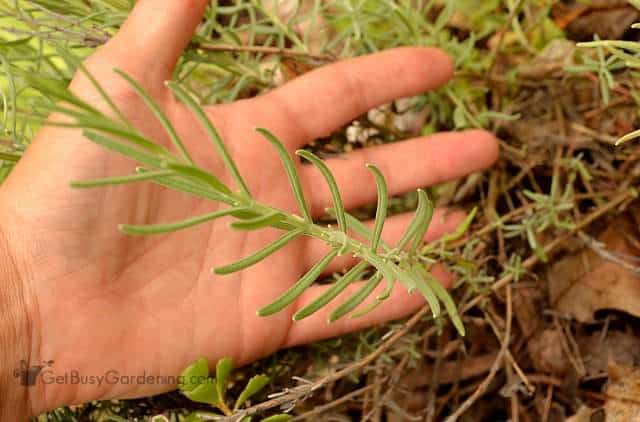
Preparing Your Cuttings For Propagation
After taking cuttings from your lavender plant, remove the bottom 3-5 sets of leaves from the stem. You can pinch them off with your fingernail, or use a sharp pair of clippers.
Stripping the bottom leaves will create small wounds (or nodes), and that’s where the roots will grow out of.
If any of the stems have already started budding, simply snip off the flower spike to give it a better chance of rooting.
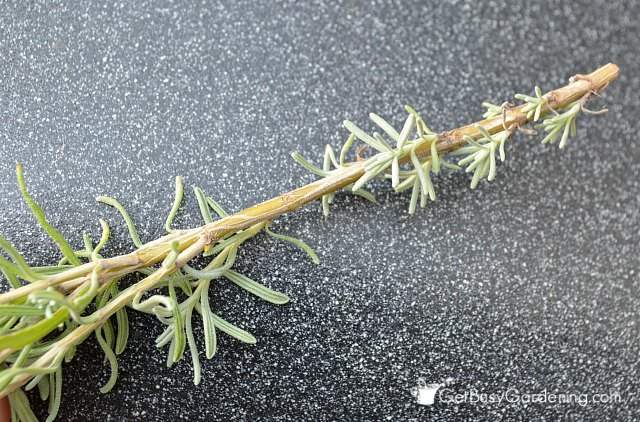
How To Propagate Lavender Step-By-Step
Below I will walk you through how to propagate lavender step by step. I’ll give you the instructions for how to do it in soil first, then I’ll list the steps for rooting them in water. They are a bit different for each, but neither method is complicated.
Steps For Propagating Lavender In Soil
Gather your supplies before you get started to speed up the process. Don’t worry, you won’t need a bunch of expensive equipment – and you probably already have some of this stuff on hand.
Supplies Needed:
- Prepared lavender cuttings
- A pot and a plastic bag
- OR a propagation chamber
- Propagation soil
- Hand trowel
- Heat mat (optional)
- Moisture gauge (optional)
- Grow light (optional)
See my detailed list of the best plant propagation tools & supplies here.
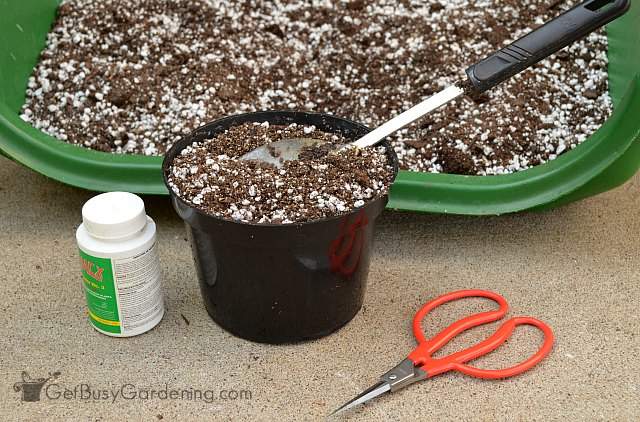
Step 1: Prepare the soil – Use a good quality well-draining mix, like seed starting soil, or make your own by combining half regular potting soil with half perlite. Moisten it lightly before filling your container.
Step 2: Fill the container – Use your hand trowel to fill the pot, leaving about 1 inch of headspace below the rim. Or add 3-4” of the medium into the bottom of your propagation chamber.
Step 3: Make a hole – Before sticking your cutting into the soil, poke a 2-3″ deep hole with your finger. That way you won’t accidentally break the delicate stems when you plant them.
Related Post: How To Harvest Lavender Fresh From The Garden
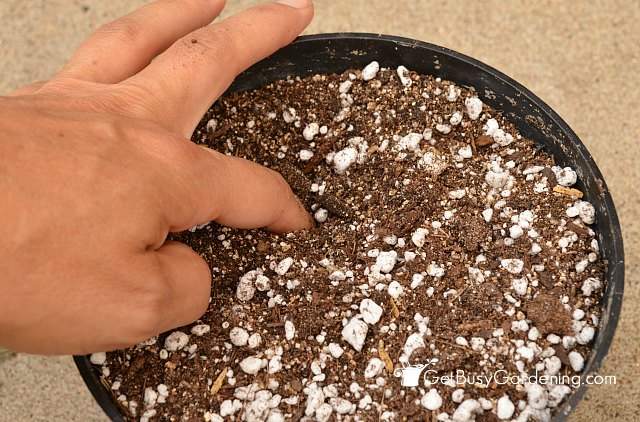
Step 4: Plant the stem – Stick the leafless part of the stem into the hole that you made. Then gently press the soil around it so the cutting stands up on its own, and the medium comes in good contact with the stem.
Step 5: Add the rest of the cuttings – You can put several into one large pot or your propagation chamber. But space them apart far enough so they don’t touch each other. This will ensure adequate airflow, and help to avoid mold or rot.
Related Post: How To Collect Lavender Seeds From Your Garden
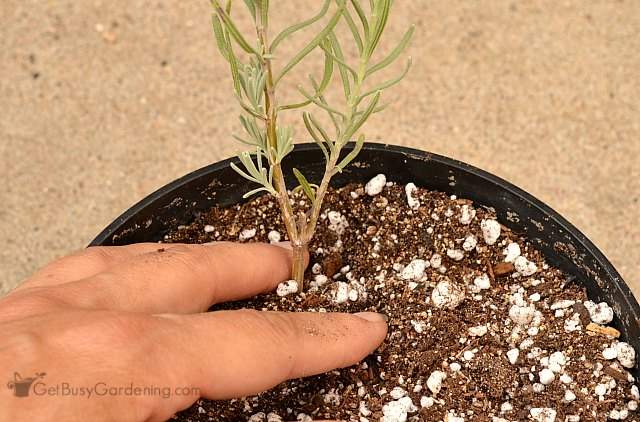
Step 6: Cover the container – If you’re using a propagation box, then simply put the lid on it. Otherwise, tent a plastic bag over the entire pot to help provide extra humidity. Make sure the plastic is not touching any of the leaves.
Step 7: Put it in a warm spot – Outdoors, place the container in a warm location where your lavender cuttings will be protected from direct sunlight, wind, and heavy rain during propagation. Indoors you should use a grow light if it’s dark, and a heat mat if it’s cold.
Step 8: Monitor soil moisture: Keep the soil evenly moist, but not wet or soggy. Check daily to make sure that it never dries out completely. Use a moisture gauge if you struggle with this.
Step 9: Watch for roots: You’ll know your lavender cuttings have started rooting when you see new leaves growing on the top. They also won’t move when you gently tug on them.
Related Post: How To Dry Lavender From Your Garden
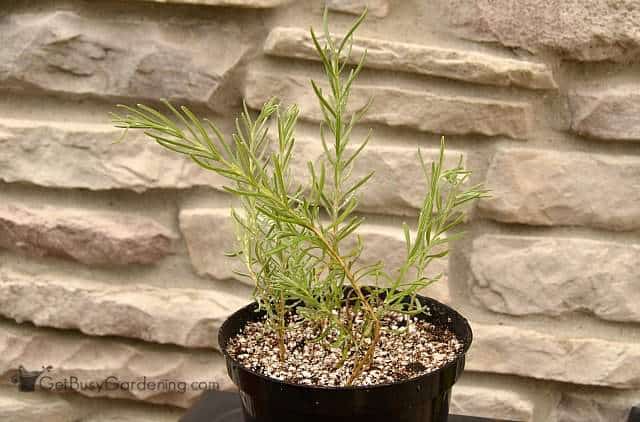
Steps For Propagating Lavender In Water
Propagating lavender in water is another option, BUT there is a downside. The roots tend to be weaker, which means the cuttings can suffer from severe transplant shock. So they may have a lower survival rate with this method.
Supplies Needed:
- Prepared lavender cuttings
- Vase
- Tepid water
- Decorative rock (optional)
- Grow light (optional)
Step 1: Put decorative rock in bottom of vase (optional) – I like to put an inch or so of decorative rock into the bottom of my vase. That will make it more sturdy, and looks nice too. It’s totally optional though, and won’t help the cuttings root any faster.
Step 2: Fill the vase – Pour room temperature (tepid) water into the vase until it’s about 1/2 – 3/4 full. I prefer to use filtered, distilled, or rainwater, but you can use tap water if that’s your only option.
Step 3: Add the cuttings – Put your lavender stems into the vase just like you would with fresh flowers. Make sure none of the leaves are touching the water though, or they may rot or mold.
Step 4: Place in a warm, bright location – Keep the vase somewhere that is warm and receives plenty of indirect sunlight. If you don’t have a sunny spot, then add a grow light.
Step 5: Monitor the water – Check the water level regularly to make sure it stays clear and doesn’t evaporate. Refresh it if it drops below the roots or appears murky, to prevent your cuttings from drying out or rotting.
How Long Do Lavender Cuttings Take To Root?
It can take anywhere from 3-6 weeks for roots to develop on your lavender cuttings. The warmer and more humid it is, the faster they will root.
They may start forming a little faster in water than in soil, depending on the humidity and heat levels. Wait until there are several thick roots that are at least 3-4 inches long before you attempt to pot them up.
Why Won’t My Lavender Propagate?
Lavender cuttings won’t root if it’s too cold or wet for them, and it can be more difficult to propagate them in water than it is in soil.
For the best and quickest results, keep the air humid and warm, and make sure the soil is never saturated or soggy.
Tips For Transplanting Rooted Lavender Cuttings
Once the roots are established, it’s time to transplant your lavender starts into their own pots. If you propagated them in soil, you can leave them in the container until they’re ready to go into the garden.
Remove the plastic cover, and move them into the sun. You should also allow the soil to dry out a bit between waterings.
Once they’re ready to go into the ground, I recommend planting them on a shady day, or in the early evening after the intense heat of the sun has passed. Learn more in my comprehensive lavender plant care guide.
Propagating lavender is pretty darn easy, and it’s rewarding too. Once you get the hang of it, you’ll have tons of babies to share with friends and family, or to fill your garden beds.
Do you want to learn how to multiply all of your plants? Then my Plant Propagation eBook is for you! It will show all you need to know to get as many new plants as you want from your existing ones. Grab your copy today!
Share your lavender propagation tips in the comments section below!
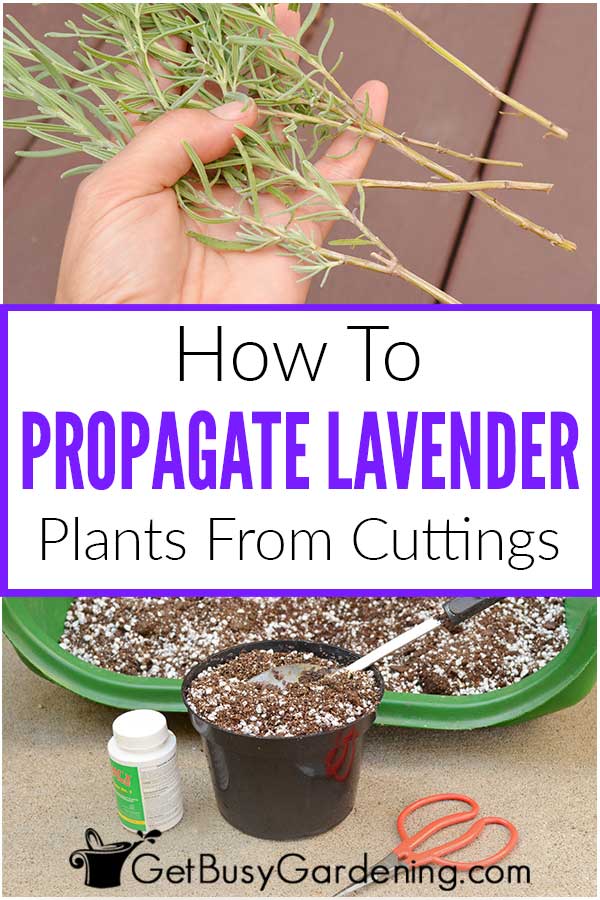
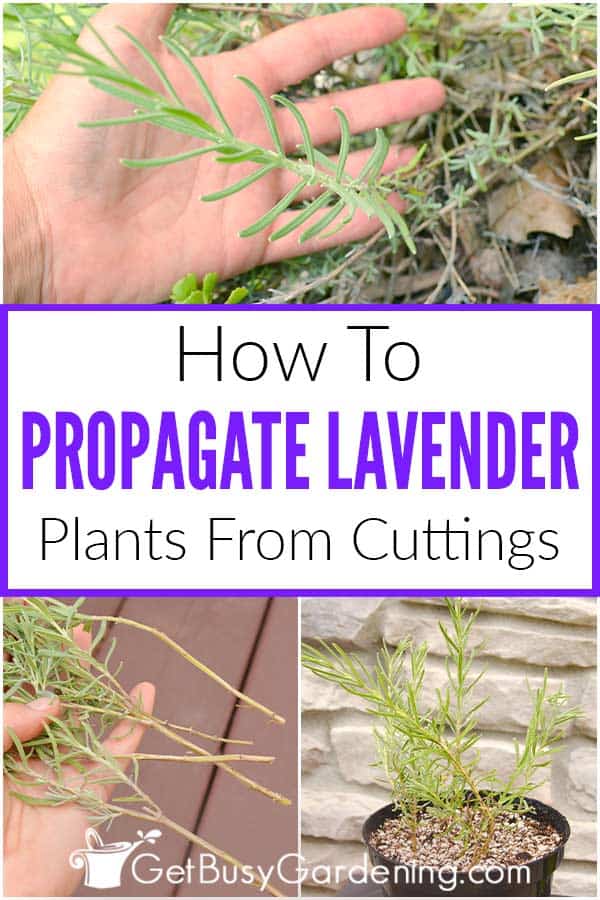
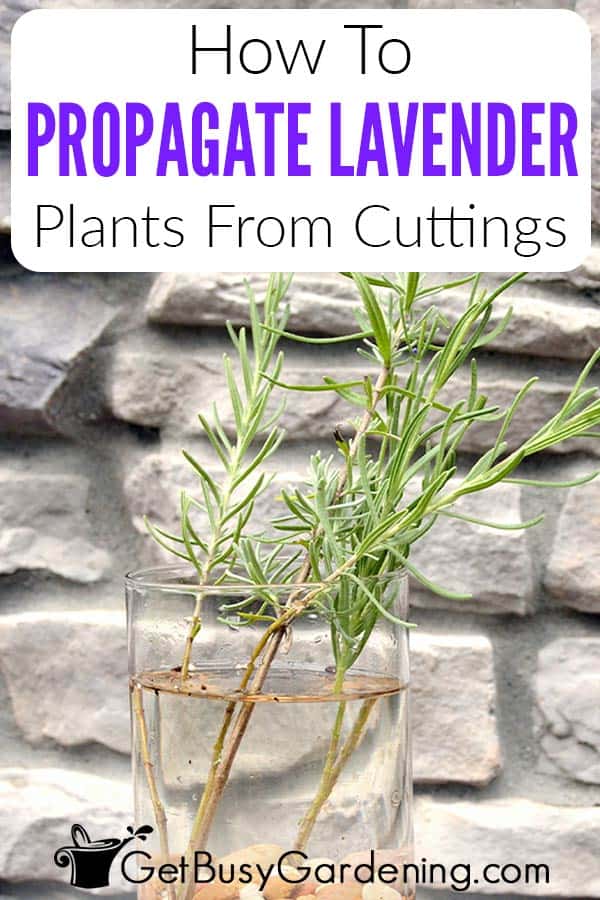
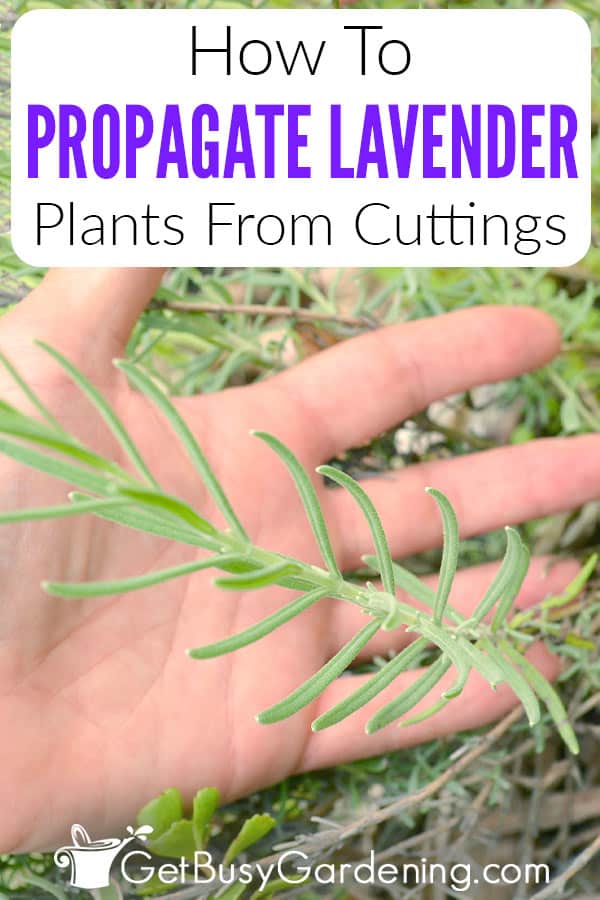
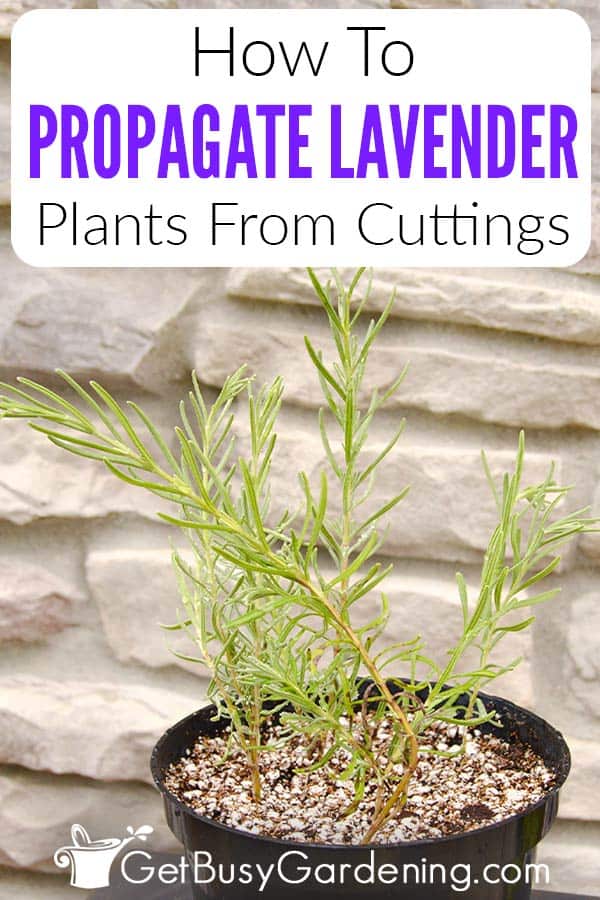
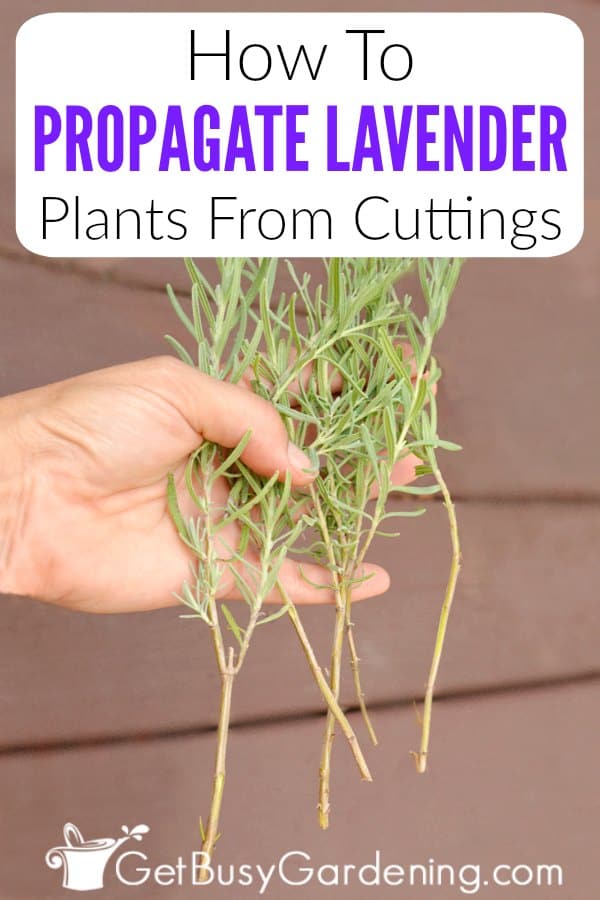
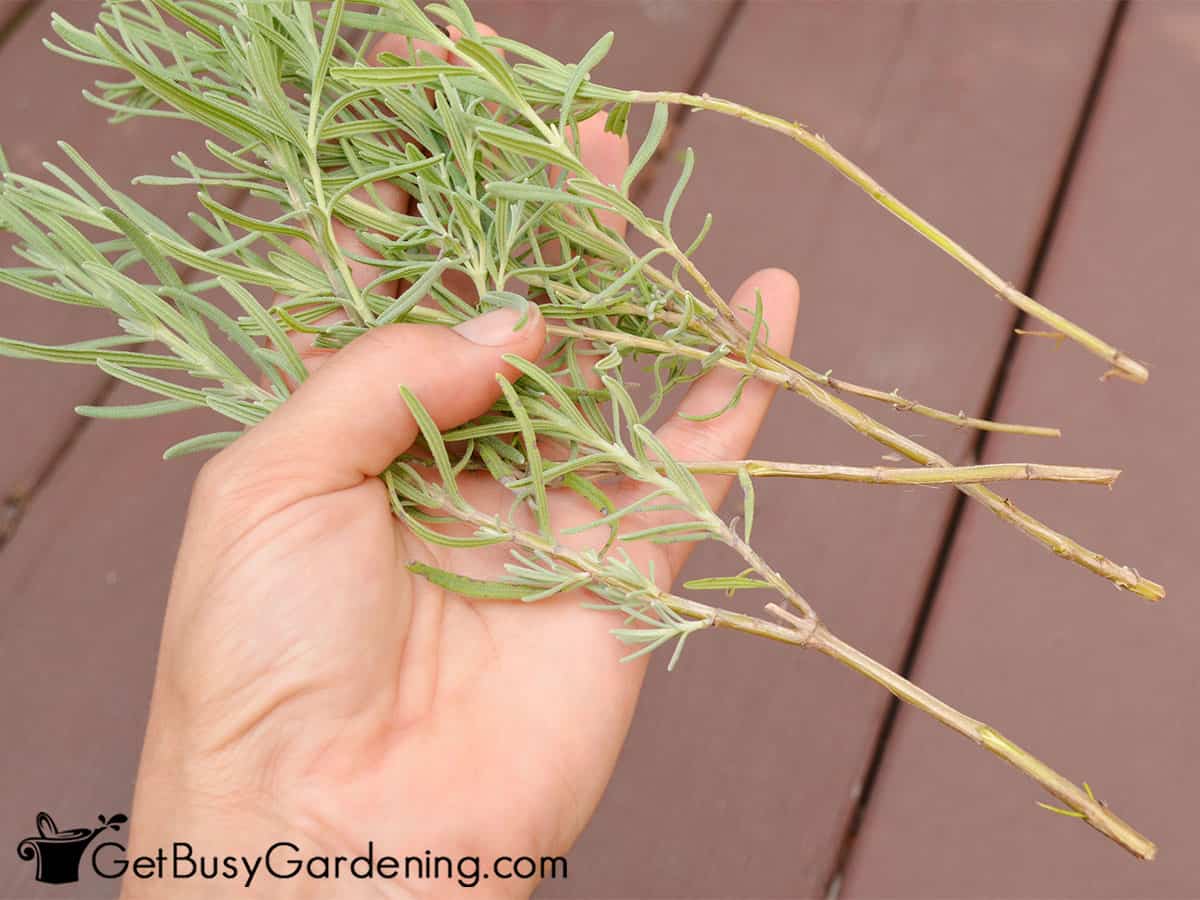

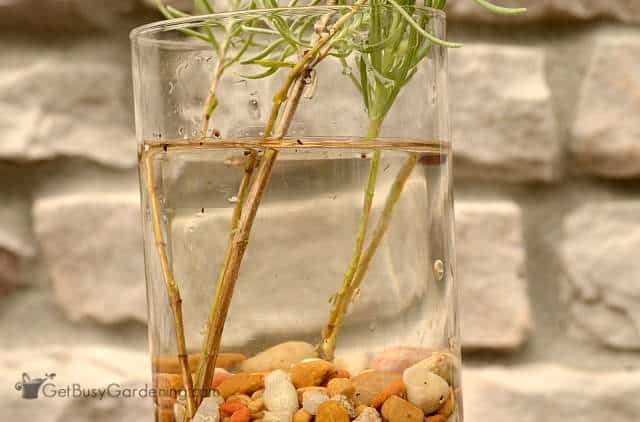


Adrienne says
I live in NY and have been growing a lavender plant in the yard. It s huge but I don’t seem to get the flower. I see buds at the tips but no lavender has ever grown. What am I doing wrong?
Thank you for any help
Amy Andrychowicz says
There are a few reasons why your lavender plant isn’t blooming. Mainly it could be acidic soil, not enough sun, over fertilizing, or improper pruning. Here are a few articles that will help you give them the proper care so they will bloom profusely…
– How To Prune Lavender: A Step-By-Step Guide
– How To Care For Lavender Plants
Seth Chuter says
I am new to gardening. Our English lavender plant looks pretty awful. The base parts are brown, dry and stiff, the roots don’t seem squishy or soft or anything (I repotted it) but it’s still growing new healthy bits at the last few inches literally just enough length to take cuttings. What causes this ? So I can prevent it next time hopefully. It looks dead and patchy but obviously isn’t fully.
Also I’ve plastic bagged the tops of mine and they’re in our conservatory, we have sun protectors on most of the windows so it doesn’t get full daylight but we’ve no greenhouse. The bag makes moisture so do I still water them ? And if so how often and what sort of amount ? Is tipping water into the tray underneath the two pots okay ? I don’t want to over or underwater them. Thank you.
Amy Andrychowicz says
Lavender plants don’t like a lot of water or humidity, so my guess is that at some point it was overwatered and hasn’t fully recovered. I would definitely remove the plastic bag, or it will just make the problem worse and possible cause it to mold. Wait until the soil feels dry 1-2″ deep before watering again, and never leave the pots soaking – make sure the excess drains completely out of the bottom of the pot, and empty the drip tray. Here are a few other posts to help you out…
How To Care For Lavender Plants
Pruning Lavender: A Step-By-Step Guide
Rachael says
Hi Amy, I just rescued 12 potted lavender from a shop that was going to throw them out. They are beautiful on 3/4 of the plant tops, with lots of leaves and flower buds but the bottom 1/4 closest to the soil has grayish, drying and drooping leaves. I think they may have been boxed too long. I’ve watered them and like I said the tops of the plants are coming back. I have the perfect place to keep them inside where they will get lots of sun over the winter. I’m thinking to plastic bag them so they don’t dry out from the heaters running all winter in my house. Does this sound OK to you?
Amy Andrychowicz says
Oh how cool, what a score! Yes, you’ll definitely need a sunny window for growing lavender indoors. They were probably neglected at the garden center, which happens a lot at the end of the season, and that’s why the bottom leaves are brown. That’s usually from improper watering. I don’t recommend putting a plastic bag around them though, because that can cause issues with disease and rot. They do pretty well in dry climates, so they don’t need a ton of humidity. Since you have so many of them, you could definitely try overwintering a few in an unheated garage or basement, especially if the are the hardier English variety. I’ve never tried this with lavender myself, but have done it for many other types of perennials. It works great, and makes it much easier to get them through the winter, since you don’t have to give them much care. Just a thought, and maybe a fun experiment for you to try. 🙂
Sadie says
Hello Amy
Thank you for this lovely post. I adore lavender and am looking forward to propagating from my friend’s plant. I am living in Perth, WA. Would you still recommend taking cuttings during the summer? It is currently spring here and my friend is moving house soon. Is there any way to take them early?
All the best 🙂
Amy Andrychowicz says
You can take lavender cuttings as soon as the plant puts on new growth in the spring/early summer. So, if you can get some healthy stems with plenty of leaves, then you can propagate them.
Blanca says
Hi. So I started propagating lavender cuttings in soil and water. Hoe often should I water the ones in soil? I plan on putting in on bathroom window with bag over it. And for the ones in water, can I mist to give it more humidity? How often should I change water?
Amy Andrychowicz says
You should moisten the soil before placing the baggie over the top of your lavender cuttings, then leave it be until you see new leaves or roots forming. The soil should stay moist under the plastic, so you shouldn’t have to water them while they are rooting. No need to mist the ones in water. Change the water only if it becomes murky and/or stinky. Otherwise, just top it off as it evaporates.